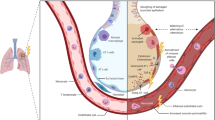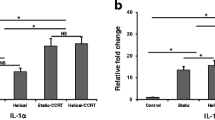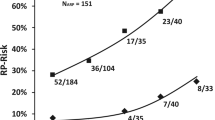Abstract
There are no data regarding the late toxicity of trastuzumab (T) administration with radiotherapy (RT). In this experimental study, we aimed to asses if concurrent or sequential administration of T has any impact for the development of radiation-induced pulmonary fibrosis in rats. Fifty-four female Wistar-albino rats were divided into 6 groups. First group of rats (Group 1; concurrent T) had irradiation to whole thoracic region concurrently with T. Second group (Group 2: sequential T–RT) received thoracic irradiation, 1 week after T. Third group (Group 3: sequential RT–T) had thoracic irradiation first and they had T injection 1 week after RT. Fourth group (Group 4: T only) had only T application. Fifth group (Group 5: RT) had only RT. The last group (Group 6: sham) of rats were observed without any application. A single dose of 12 Gy was given to both lungs with an anterior field at 2 cm depth. T dose which was equivalent to 6 mg/kg adult dose was calculated for each rat, and injected by the tail vein. As an end point the extent of pulmonary fibrosis for each field was graded on a scale from 0 (normal lung or minimal fibrous thickening) to 4 (total fibrous obliteration of the field) at histopathological examination. The mean value of fibrosis scores were 1.44, 1.77, 1.75 and 1.62 for Group 1, 2, 3 and 5, respectively, without any statistically significant differences among them (P > 0.05). The mean value of fibrosis scores for Group 4 and 6 were 0.25 and 0.33, respectively (P > 0.05). When the mean value of fibrosis scores of the groups which had RT with or without T, compared with the observation and the T only groups, the difference was significant (P < 0.05) (one-way ANOVA and Tukey HSD post hoc tests) As a conclusion: addition of T to thoracic irradiation either sequentially or concomitantly did not increase radiation-induced pulmonary fibrosis in rats.


Similar content being viewed by others
References
Slamon DJ, et al. Human breast cancer: correlation of relapse and survival with amplification of the HER-2/neu oncogene. Science. 1987;235:177–82.
Belkacémi Y, et al. Concurrent trastuzumab with adjuvant radiotherapy in HER2-positive breast cancer patients: acute toxicity analyses from the French multicentric study. Ann Oncol. 2008;19:1110–6.
Romond EH, et al. Trastuzumab plus adjuvant chemotherapy for operable HER2-positive breast cancer. N Engl J Med. 2005;353:1673–84.
Piccart-Gebhart MJ, et al. Trastuzumab after adjuvant chemotherapy in HER2-positive breast cancer. N Engl J Med. 2005;353:1659–72.
Smith I, et al. 2-year follow-up of trastuzumab after adjuvant chemotherapy in HER2-positive breast cancer: a randomised controlled trial. Lancet. 2007;369:29–36.
Joensuu H, et al. Adjuvant docetaxel or vinorelbine with or without trastuzumab for breast cancer. N Engl J Med. 2006;23(354):809–20.
Whelan T, Darby S, Taylor S, McGale P, Ewertz M. 2006 update of the early breast cancer trialists’ collaborative group overview of radiation therapy for early breast cancer. ASCO Educational Booklet. 2007;3:6.
Fisher B, et al. Twenty-year follow-up of a randomized trial comparing total mastectomy, lumpectomy, and lumpectomy plus irradiation for the treatment of invasive breast cancer. N Engl J Med. 2002;347:1233–41.
Pietras RJ, et al. Monoclonal antibody to HER-2/neureceptor modulates repair of radiation-induced DNA damage and enhances radiosensitivity of human breast cancer cells overexpressing this oncogene. Cancer Res. 1999;59:1347–55.
Raben S, et al. Comparison of acute breast and chest wall toxicity in women treated with external beam radiation with and without concurrent herceptin in a community cancer center. Int J Radiat Oncol Biol Phys. 2006;66(Suppl. 1):S541–2.
Bellon JR, Gover MT, Burstein HJ, Harris JR, Harris LN. Concurrent Trastuzumab and radiation therapy in the adjuvant treatment of breast cancer. Int J Radiat Oncol Biol Phys. 2005;63(Suppl. 1):S55–6.
Halyard MY, et al. Radiotherapy and adjuvant trastuzumab in operable breast cancer: tolerability and adverse event data from the NCCTG Phase III Trial N9831. J Clin Oncol. 2009;27:2638–44.
Horton JK et al. Radiosensitization of chemotherapy-refractory, locally advanced or locally recurrent breast cancer with Trastuzumab: a phase II Trial. Int J Radiat Oncol Biol Phys. 2009 Jun 26. [Epub ahead of print].
Bese NS, et al. The effects of tamoxifen on radiation-induced pulmonary fibrosis in Wistar albino rats: results of an experimental study. Breast. 2006;15:456–60.
Pegram M, Ngo D. Application and potential limitations if animal models utilized in the development of trastuzumab: a case study advanced drug delivery reviews. Adv Drug Deliv Rev. 2006;58:732–4.
Ward HE, Kemsley L, Davies L, Holecek M, Berend N. The pulmonary response to sublethal thoracic irradiation in the rat. Radiat Res. 1993;136:15–21.
Ashcroft T, Simpson JM. Timbrell V: simple method of estimating severity of pulmonary fibrosis on a numerical scale. J Clin Pathol. 1988;41:467–70.
Daniel WW. Biostatistics: a foundation for analysis in the health sciences. 6th ed. New York: Wiley; 1995. p. 273–312.
Sawyer DB, Zuppinger C, Miller TA, Eppenberger HM, Suter TM. Modulation of anthracycline-induced myofibrillar disarray in rat ventricular myocytes by neuregulin-1beta and anti-erbB2: potential mechanism for trastuzumab-induced cardiotoxicity. Circulation. 2002;105:1551–4.
Slamon DJ, et al. Use of chemotherapy plus a monoclonal antibody against HER2 for metastatic breast cancer that overexpresses HER2. N Engl J Med. 2001;344:783–92.
Suter TM, et al. Trastuzumab-associated cardiac adverse effects in the herceptin adjuvant trial. J Clin Oncol. 2007;25:3859–65.
Bird BR, Swain SM. Cardiac toxicity in breast cancer survivors: review of potential cardiac problems. Clin Cancer Res. 2008;14:14–24.
Shaffer R, Tyldesley S, Rolles M, Chia S, Mohamed I. Acute cardiotoxicity with concurrent trastuzumab and radiotherapy including internal mammary chain nodes: a retrospective single-institution study. Radiother Oncol. 2009;90:122–6.
Stone HB, et al. Effects of radiation on normal tissue: consequences and mechanisms. Lancet Oncol. 2003;4:529–36.
Conflicts of interest notification
There are no declared conflicts of interest concerning this manuscript.
Author information
Authors and Affiliations
Corresponding author
Rights and permissions
About this article
Cite this article
Bese, N.S., Umay, C., Serdengecti, S. et al. The impact of trastuzumab on radiation-induced pulmonary fibrosis: results of an experimental study. Med Oncol 27, 1415–1419 (2010). https://doi.org/10.1007/s12032-009-9395-5
Received:
Accepted:
Published:
Issue Date:
DOI: https://doi.org/10.1007/s12032-009-9395-5




